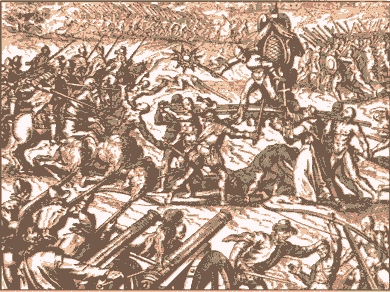Conquest Information

At the time of Pizarro's arrival, the Inca had
already been weakened due to a civil war over which of the two king's
sons would become next king. Normally the king would choose which of his
sons will succeed him, but the Sapa Inca had died of smallpox before he
could choose. The resulting anger started the Inca Civil War. (For a
discussion of Inca population, see Inca Empire.)
When the Spanish arrived at the borders of the Inca Empire in 1528, the
empire spanned a considerable distance. Extending southward from the
Ancas Maya (meaning Blue River) which is now known as the Patia River in
southern Colombia to the Maule River in Chile, and eastward from the
Pacific Ocean to the edge of the Amazonian jungles, the empire covered
some of the most mountainous terrain on earth. In less than a century
the empire had grown in extent from about 155,000 sq mi/400,000 km2 in
1448, to 380,000 sq mi/980,000 km2 (or about the size of the eastern
seaboard of the United States) in 1528, just before the arrival of the
Spaniards. This vast area of land varied greatly in both culture and in
climate. Because of the greatly varying cultures and geography, many
areas of the empire were left under local leaders, who were watched and
monitored by Inca officials. However, under the administrative
mechanisms established by the Incas, all parts of the empire answered
to, and were ultimately under the direct control of, the Emperor.
Scholars estimate that the population of the Inca Empire probably
numbered over 16,000,000.
Some scholars believe that while the Spanish conquest was undoubtedly
the proximate cause of the collapse of the Inca Empire, it may very well
have been past its peak and in the process of decline. In 1528, Emperor
Huayna Capac (Young Lord) ruled the Inca Empire (or as the Incans called
it, Tahuatinsuyu, or the "Land of the Four Quarters", which referred to
the four major administrative areas into which the empire was divided).
He could trace his lineage back to a "stranger king" named Manco Capac,
the mythical founder of the Inca clan, who supposedly emerged from a
cave in a region called Pacariqtambo.
More importantly, Huayna Capac was the son of the previous ruler, Topa
Inca, and the grandson of Pachacuti, the Emperor who had begun the
dramatic expansion by conquest of the Inca Empire from its base in the
area around Cuzco. On his accession to the throne, Huayna Capac had
continued the policy of expansion by conquest by bringing Inca armies
north into what is today Ecuador. While he also had to put down a number
of rebellions during the course of his reign, by the time of his death
his legitimacy was as unquestioned as was the reality of Inca power.
Expansion had created problems, however. Per force, many parts of the
empire maintained their cultural identity, and were at best restive
participants in the imperial project. The large extent of the empire,
the extremely difficult terrain of much of it, and the fact that all
communication and travel had to take place on foot, seems to have caused
increasing difficulty in administering the empire effectively.
Among the most important aspects of Huayna Capacís reign were his sons.
While he had many legitimate and illegitimate children (legitimate
meaning born of his sister-wife), two sons are historically important.
The first was Prince Tupac Cusi Hualpa, also known as Huascar, whose
mother was Coya (meaning Empress) Mama Rahua Occllo. The second was
Atahualpa, an illegitimate son who was likely born of a daughter of the
last independent King of Quitu, one of the states conquered by Huayna
Capac during the great expanse of the Inca Empire. These two sons would
play pivotal roles in the final years of the Inca Empire.
Pizarro and his men were greatly aided in their enterprise by the fact
that they arrived when the Inca Empire was in the midst of a war of
succeession between princes Huascar and Atahualpa. Atahualpa seems to
have spent more time with Huayna Capac during the years when he was in
the north with the army conquering Ecuador. Atahualpa was thus closer
to, and had better relations with the army and its leading generals.
When both Huayna Capac and his eldest son and designated heir, Ninan
Cuyochic, died suddenly in 1528 from what was probably smallpox, a
disease introduced by the Spaniards into the Americas during their
conquest of Mexico, the question of who would succeed as emperor was
thrown open. At the time of Huayna Capac's death Huascar was in the
capital Cuzco, while Atahualpa was
in Quitu with the main body of the Inca army. Huascar had himself
proclaimed Sapa Inca (i.e. Emperor) in Cuzco, but the army declared its
loyalty to Atahualpa, setting the stage for a civil war.
| Related Sites: Inca Trail to Machu Picchu - Inca Trail Peru - Inca Trail Trek - Inca Trail |